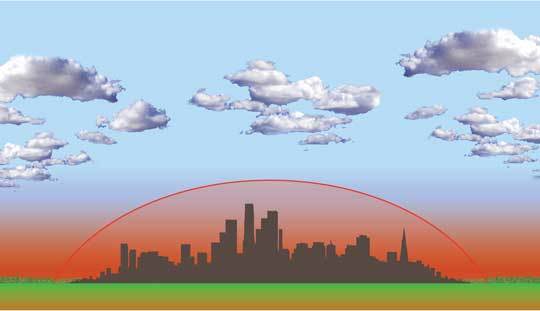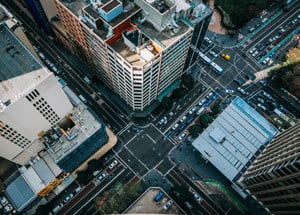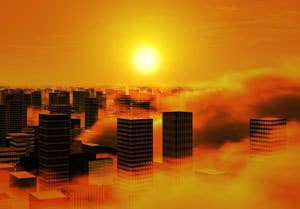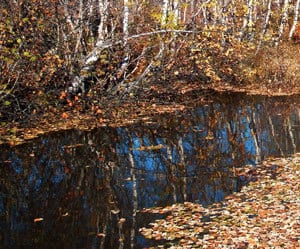What Is An Urban Heat Island And How Does It Affect The Weather?

In general, local weather conditions may differ from broader regional weather. However, Urban Heat Island, commonly encountered in densely populated areas, creates an entirely different environment.
An Urban Heat Island can be defined as a densely populated area that is substantially warmer than the surrounding region. Higher temperatures are mainly a result of urban infrastructure and human activity. Temperatures are generally higher throughout the day but most noticeable during the evening.
The term "Urban Heat Island" may not be that familiar, but anyone living in a city or densely-populated already experienced this phenomenon. And unlike other atmospheric conditions, this localized weather occurrence is entirely the result of human activity.
(We already discussed the difference between local and regional weather in detail in a separate article. You can read more about these differences in this article.)
The term is not used to describe a certain size area in which weather conditions are reported, but rather a space created by human activity, which created its own microclimate.
Before looking at how this phenomenon occurs and what its impact is, one first needs to define what an Urban Heat Island is.
Urban Heat Island Definition

An Urban Heat Island can be defined as a densely populated area that is substantially warmer than the surrounding region. Higher temperatures are mainly a result of urban infrastructure and human activity. Temperatures are generally higher throughout the day but most noticeable during the evening.
Infrastructure (concrete buildings, glass & asphalt roads) is the primary contributor due to its ability to maintain and trap heat within this environment. This is also why the difference in temperature is wider during the night than during the day.
The second-largest contributor to Urban Heat Islands is human activity, like the heat produced by transportation (buses, cars, and trains), the heating of homes, and the heat generated by human bodies and respiration.
Now that you have a clear idea of what an Urban Heat Island is, we can drill down into the specifics to find out how this microclimate is created.
Causes Of The Urban Heat Island
We already identified the main factors responsible for the formation of a UHI (Urban Heat Island). But to see how exactly these factors create this effect, they need to be examined in more detail.
1) Infrastructure
Infrastructure can be considered as the primary cause of the UHI effect. The majority of a city is covered by concrete, asphalt, glass, and metal.
The attributes of concrete and asphalt allow them to absorb and maintain heat throughout the day and well into the night. This makes the temperatures in the city significantly higher than the surrounding rural area.
Reflective materials like glass and metal allow heat to be reflected and scattered onto the already warm concrete, asphalt, and other heat-absorbent materials in the city.
2) Transport

As a city has a high concentration of humans living and working in a relatively small area, a higher volume of transportation is required.
This means more buses, cars, and trains which all make use of heat-generating engines. The sheer volume of transportation in a city, it will quickly make it obvious how much extra heat is generated and contributing to the UHI effect.
3) Respiration And Emissions
To a lesser extent, our own bodies are also a source of heat in more than one way. In this section, we will just focus on our respiration. The air we inhale is warmed up by our bodies, causing the air we exhale not only to be more toxic but also much warmer.
A similar process occurs with internal combustion engines used by buses and motor vehicles. The air escaping through each vehicle's exhaust also produces toxic, but more importantly, heated air.
4) Lack Of Vegetation
The one thing rural regions have in abundance that metropolitan areas don't is vegetation. And it's vegetation that helps the environment to cool off throughout the day. Plants and trees absorb carbon dioxide and release fresh oxygen-rich air into the atmosphere.
But of more importance is the evapotranspiration (evaporation and transpiration) process. The process involves soil in between vegetation, treetops, as well as plant leaves themselves, releasing moisture into the atmosphere, which has a significant cooling effect.
Traditional metropolitan and other densely populated urban areas contain almost no or very little vegetation. In contrast, the urban surface contributes to heating rather than cooling the surrounding air, as is the case when plenty of plants and trees are present.
5) Urban Canyon (Street Canyon) Effect
The streets and alleyways spread throughout the city and flanked by tall buildings, create a flow of air similar to that present in a canyon, hence the name, "Urban or Street Canyon."

This occurrence greatly contributes to the UHI effect. The tall buildings inhibit the free flow of air through the city, causing the heat generated by the city's infrastructure to be trapped in the air above the streets and between the buildings.
There are many other factors also contributing to the creation of the Urban Heat Island Effect, but the ones just mentioned play the biggest part.
Features And Effects Of An Urban Heat Island
During the description at the beginning of the article, the heat difference caused by a UHI and the rural surrounding was mentioned. By looking at the characteristics of an Urban Heat Island, you will be able to better understand how exactly it functions.
1) Difference In Temperature
The air of a metropolitan area is not just much warmer than the surrounding rural areas, but the temperature difference also does not stay the same throughout the day (24 hours).
During the evenings, the difference in temperature is much larger than during the day. The average yearly difference in temperature between metropolitan and rural areas is around 1–3° Celsius (1.8–5.4° Fahrenheit) during the day.
During the evenings, though, the average yearly difference in temperature can increase to 12° Celsius (22° Fahrenheit). The big difference in nighttime temperature is mainly due to the way in which the surface areas cool down.
Here, two familiar factors have the greatest impact:
a) Urban Infrastructure
The concrete, asphalt, and reflective materials that cause metropolitan areas to heat up more than rural areas, also maintain the heat and radiates the warm air well into the night, causing the city to remain warm.
The tall buildings also prevent vital air movement, trapping the heat inside. The normal current of upward moving the air when the surface is heated, called convection, usually removes warm air from the surface. This process can not take place in this environment.
b) Lack Of Vegetation
The benefits of vegetation and its ability to cool down rural areas have already been explained in detail. The lack of vegetation in densely populated urban environments and metropolitan areas further diminishes these areas' capability to cool down effectively.
(City planners are realizing this shortcoming, and modern cities are designed to incorporate "green zones" which contain dense sections of green vegetation. Any area that can be further utilized to accommodate plants and trees is increasingly being used.
Rooftop gardens are one such case where the roofs of buildings are converted into living gardens rich in leafy plants, grass, and trees. The cumulative effect of incorporating vegetation throughout the city can make a huge impact on effectively cooling it down.)
2) Accumulation Of Photochemical Smog And Other Toxic Gases
Unfortunately, not only the warm air but all the pollutants and toxic gases produced within the UHI are also trapped in this "Urban Heat Dome." This has a negative effect on both human health and the environment.

The brown haze you see hanging over a city, normally early in the morning or late afternoon, is called Photochemical Smog. Photochemical Smog forms when ultraviolet rays of the sun react with nitrogen oxides (gases produced by the burning of fossil fuels).
This is not the only pollutant hazardous to human health that accumulates in the air within an Urban Heat Island. Carbon dioxide is a greenhouse gas that is not only harmful to humans but also contributes to global warming and climate change.
Carbon dioxide is produced by the burning of fossil fuels (primarily through transport emissions, but also through the burning of wood and coal.) To find out more about carbon dioxide and its wide-ranging effects, you can read the full article here.
Ozone levels are also raised due to photochemical interactions created by the UHI. Ozone, which is crucial gas for protecting the earth from the sun's harmful UV radiation, is the cause of a range of respiratory problems when coming into direct contact with humans.
A range of other harmful pollutants is also present in the air, which is unable to escape due to the UHI effect. These include sulfur dioxide, dust particles, lead, hydrocarbons, and carbon monoxide.
3) Impact On Bodies Of Water And Pollution
Indirectly, the warm air even affects the water quality of bodies of water in or near the Urban Heat Island. Water that ends up in rivers, ponds, and dams, starts its journey far away from where it ends up.
As rain falls in a metropolitan area that is experiencing the UHI effect, the raindrops fall on warm rooftops, pavements, and streets. They run down warm drainpipes before being collected by drains and carried away by stormwater runoffs.
The water can travel for miles before reaching a river, dam, or pond. It has been determined that the UHI effect can warm the rainwater from 21° Celsius (70° Fahrenheit) all the way up to 35° Celsius (95° Fahrenheit).

Aquatic life is very sensitive to changes in water temperature, and an influx of warm water can be devastating, endangering the livelihood of many fish and other aquatic species.
A further danger comes from standing water with warm temperatures. These types of conditions are ideal for deadly waterborne diseases to develop and spread, helped along by the carcasses of dead aquatic creatures and excrement.
Especially in rural communities that rely on water from rivers and reservoirs close to the city, people are very exposed to the deadly diseases that can spread under these conditions.
You can learn more about these waterborne diseases that are the main cause of fatalities in India during the Monsoon season (which are also a result of standing warm water) in this article. Look towards the end of the article under the "Monsoon Section."
4) Direct Impact Of Elevated Temperatures On Human Life
The first and most important characteristic of an Urban Heat Island is the elevated temperature. It is the much warmer conditions that have the most profound effect on human health and well-being.

This is particularly obvious during summer months when the UHI effect causes the highest temperatures to be recorded. During this period it is people with developing and weakened immune systems to be most prone to be affected by heat-related diseases.
Children and the elderly fall into this group. Children (and adults) can easily suffer from heatstroke, headaches and dizzies, cramps, and respiratory problems. Although very few of them are fatal, these conditions have now been linked to long-term organ damage.
People, especially the elderly, with existing health conditions like asthma, diabetes, and cardiovascular disease, are especially hard hit by the increased temperature.
Every year, the rate of fatalities has shot up during periods of high temperatures, especially among the elderly. And this is a worldwide phenomenon, especially in Western Societies where urbanization and concentrated metropolitan areas are developing at a record rate.
Conclusion
There should be no doubt left in your mind that the Urban Heat Island Effect is very real, and its impact on the environment and human health is much bigger and more significant than anyone expected it to be.
Although not on such a large scale, the UHI also has a small but significant impact on global warming and climate change, as well as the UHI's immediate surroundings.
The difference between the microclimate of Urban Heat Islands and nearby rural areas can be so significant that many people are turning to home weather stations to measure the atmospheric conditions in their surroundings.
You can read more about why you may need the convenience and the added assurance of a home weather station in this article.
I trust you now have a clear and thorough understanding of what an Urban Heat Island is, how it is created, and the effects it has on the weather and its surroundings.
Never miss out again when another interesting and helpful article is released and stay updated, while also receiving helpful tips & information by simply clicking on this link .
Until next time, keep your eye on the weather!

